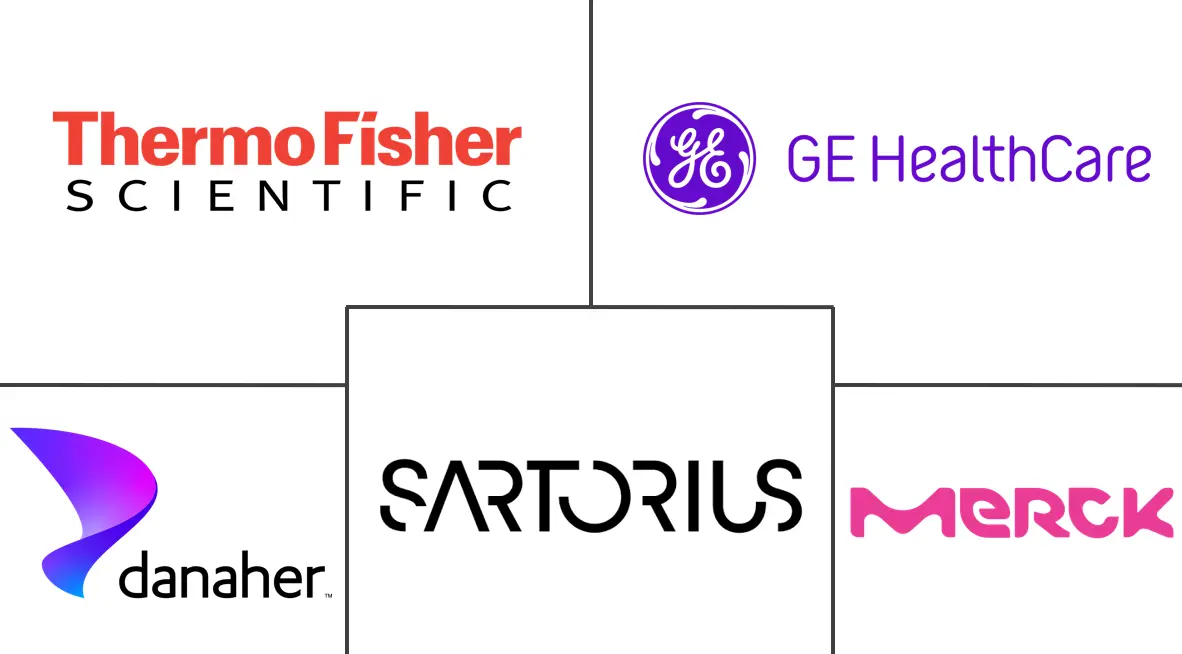Downstream Processing Market Size and Share
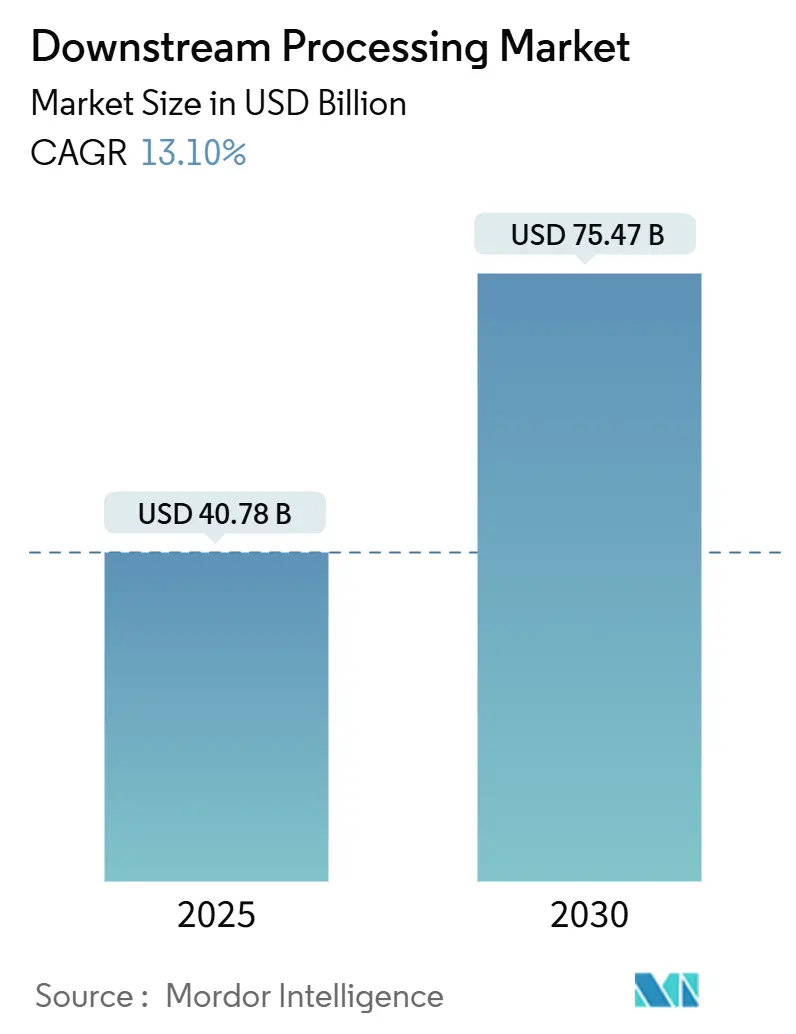
Downstream Processing Market Analysis by Mordor Intelligence
The global downstream processing market stands at USD 40.78 billion in 2025 and is projected to reach USD 75.47 billion by 2030, reflecting a compound annual growth rate (CAGR) of 13.10%. Capacity expansions valued above USD 50 billion in 2024-2025, including Eli Lilly’s USD 9 billion Indiana site and Novo Nordisk’s USD 4.1 billion North Carolina facility, have created unprecedented equipment demand and intensified competition for skilled labor. Single-use systems, continuous bioprocessing, and digital twins are now mainstream, cutting operating costs and shortening validation timelines, while suppliers race to introduce PFAS-compliant membranes before incoming regulations take effect. Outsourcing momentum further shapes pricing and technology adoption as CDMOs secure multi-year slots for niche modalities such as viral vector and lipid nanoparticle production. Meanwhile, manufacturers prioritize supply-chain resilience, driving regional sourcing strategies and dual-supplier frameworks for filters, bags, and resins.
Key Report Takeaways
- By technique, purification held 32.25% revenue share of the downstream processing market in 2024, whereas cell disruption is forecast to advance at a 15.25% CAGR to 2030.
- By product, chromatography columns and resins led with 35.53% of the downstream processing market share in 2024, while filtration and membrane devices are set to grow at 14.35% CAGR through 2030.
- By application, antibody production accounted for 43.82% share of the downstream processing market size in 2024 and cell and gene therapy products are poised to expand at a 15.26% CAGR between 2025-2030.
- By end user, biopharmaceutical manufacturers captured 48.82% of the downstream processing market size in 2024; contract development and manufacturing organizations are predicted to post the highest CAGR at 15.62% to 2030.
- By geography, North America commanded 32.82% of the downstream processing market share in 2024, whereas Asia-Pacific is projected to register a 14.62% CAGR through 2030.
Global Downstream Processing Market Trends and Insights
Drivers Impact Analysis
| Driver | (~) % Impact on CAGR Forecast | Geographic Relevance | Impact Timeline |
|---|---|---|---|
| Rapid Expansion Of Global Biologics Manufacturing Capacity | +3.2% | Global, with concentration in North America & Asia-Pacific | Medium term (2-4 years) |
| Rising R&D Spending Among Big Pharma & Emerging Biotech | +2.8% | North America & EU primarily, expanding to Asia-Pacific | Long term (≥ 4 years) |
| CMO/CDMO Outsourcing Boom, Multi-Year Capacity Deals | +2.1% | Global, with Asia leading capacity additions | Medium term (2-4 years) |
| mRNA & Viral-Vector Vaccine Platform Scale-Up Post-COVID | +1.9% | Global, with manufacturing hubs in North America & EU | Short term (≤ 2 years) |
| Continuous Bioprocessing Adoption Reducing Capex/OPEX | +1.5% | North America & EU early adopters, Asia following | Long term (≥ 4 years) |
| Source: Mordor Intelligence | |||
Rapid Expansion of Global Biologics Manufacturing Capacity
Samsung Biologics completed its fifth plant in April 2025, lifting global capacity to 784,000 L and reinforcing a volume race that lifts demand for large-scale chromatography systems and single-use bioreactors. Newly built lines favor continuous modalities that lower buffer consumption by as much as 40% and reduce water-for-injection requirements. Regional governments position biomanufacturing as a strategic growth engine, illustrated by Saudi Arabia’s plan to add USD 34.6 billion to non-oil GDP by 2040[2]Vision 2030, “National Biotechnology Strategy,” vision2030.gov.sa. Capacity oversupply among some CDMOs temporarily suppresses utilization to below 50%, yet the throughput flexibility of intensified downstream skids allows quick re-scheduling without quality compromise. Vendors consequently bundle columns, resins, and analytical sensors to deliver integrated platforms that can switch between monoclonal and viral-vector products within hours.
Rising R&D Spending Among Big Pharma & Emerging Biotech
Large enterprises lift budgets even while smaller firms face capital rationing. Eli Lilly alone earmarked USD 4.5 billion for the Lilly Medicine Foundry to accelerate clinical supply, creating incremental orders for modular chromatography and tangential flow filtration systems[1]Eli Lilly, “Lilly Announces New USD 4.5 Billion Site to Drive Innovation in Drug Production,” investor.lilly.com. Venture-backed start-ups prioritise cell and gene therapy pipelines, which require low-shear clarification and nuclease removal steps that differ substantially from antibody workflows. The result is broadened demand diversity that benefits suppliers offering configurable skids and disposable flow paths. Continuous multicolumn chromatography, once niche, is now adopted by a growing number of programs because it offsets resin cost spikes with 50% smaller bed volumes per kilogram of product.
CMO / CDMO Outsourcing Boom, Multi-Year Capacity Deals
Survey data show CDMOs could operate 54% of global biologics capacity by 2028, altering purchasing cycles for buffers, probes, and membrane adsorbers. Multi-year reserved-capacity contracts de-risk capital for smaller sponsors and accelerate technology transfer. Asia-based providers gain share by offering end-to-end viral-vector production at 20% lower cost than US peers. Standardisation of unit operations across multiple client molecules pushes suppliers to launch plug-and-play skid designs that meet GMP across jurisdictions.
mRNA & Viral-Vector Vaccine Platform Scale-Up Post-COVID
Moderna’s UK, Australia, and Canada plants entering service in 2025 heighten global need for lipid nanoparticle purification and sterile-filtration cassettes. Wacker’s German mRNA centre adds 80 million dose throughput, underscoring the pivot toward non-pandemic indications. Scale-up lessons feed back to viral-vector programs, replacing ultracentrifugation with membrane-based clarification to raise yields. The FDA guidance on innovative manufacturing technologies endorses continuous processing, unlocking regulatory confidence for end-to-end integrated downstream trains.
Restraints Impact Analysis
| Restraint | (~) % Impact on CAGR Forecast | Geographic Relevance | Impact Timeline |
|---|---|---|---|
| High Capital Cost Of Large-Scale Chromatography Skids & Resins | -1.8% | Global, particularly affecting emerging markets | Medium term (2-4 years) |
| Purification Bottleneck Versus Upstream Titers | -1.2% | Global, most acute in high-titer biologics production | Short term (≤ 2 years) |
| Supply-Chain Fragility For Single-Use Filters & Bags | -0.9% | Global, with regulatory pressure in North America & EU | Short term (≤ 2 years) |
| Source: Mordor Intelligence | |||
High Capital Cost of Large-Scale Chromatography Skids and Resins
Protein A resin still commands premium pricing, consuming up to 60% of downstream capital budgets. Purolite invested USD 200 million in a Pennsylvania plant to ease supply and blunt price volatility, yet smaller firms remain cost-constrained. Intensified multicolumn operations cut resin use by 50% and raise output per square foot, but they add automation complexity that demands trained staff. A two-tier market is emerging in which large pharma pays for premium capture resins while cost-sensitive players explore mixed-mode or continuous alternatives.
Purification Bottleneck Versus Upstream Titers
Biosimilar and antibody programs now reach titers of 8 g L, far outpacing downstream steps configured for earlier 3 g L performance. As a result, capture cycles strain scheduling windows, and in-process hold tanks become space bottlenecks. Fiber-based chromatography prototypes from Cytiva show eightfold higher mass transfer coefficients, but scalability proof remains ongoing. Facilities therefore run multiple parallel skids, increasing floor-space and staffing needs, dampening the projected downstream processing market CAGR in the near term.
Segment Analysis
By Technique: Purification Dominates, Cell Disruption Accelerates
Purification techniques accounted for 32.25% of downstream processing market revenue in 2024, confirming their centrality to biologics quality. Cell disruption registers the fastest 15.25% CAGR as microbial and intracellular expression systems gain adoption. The downstream processing market size for purification surpassed USD 13 billion in 2025 and is poised to cross USD 25 billion by 2030, supported by resin capacity expansions and multicolumn innovations. In parallel, homogenisers and microfluidisers remain the workhorses for cell disruption, but low-frequency acoustic methods are attracting pilot-scale trials because they reduce heat generation.
Continuous chromatography reduces buffer use, aligning with sustainability objectives that influence procurement in Europe. Single-use centrifuges and depth-filtration cassettes improve clarification throughput and minimise contamination risk, a feature valued in multi-product CDMO suites. Integration software that harmonises sensor readings across clarification and capture stages shortens batch release times, offering a competitive edge to early adopters.
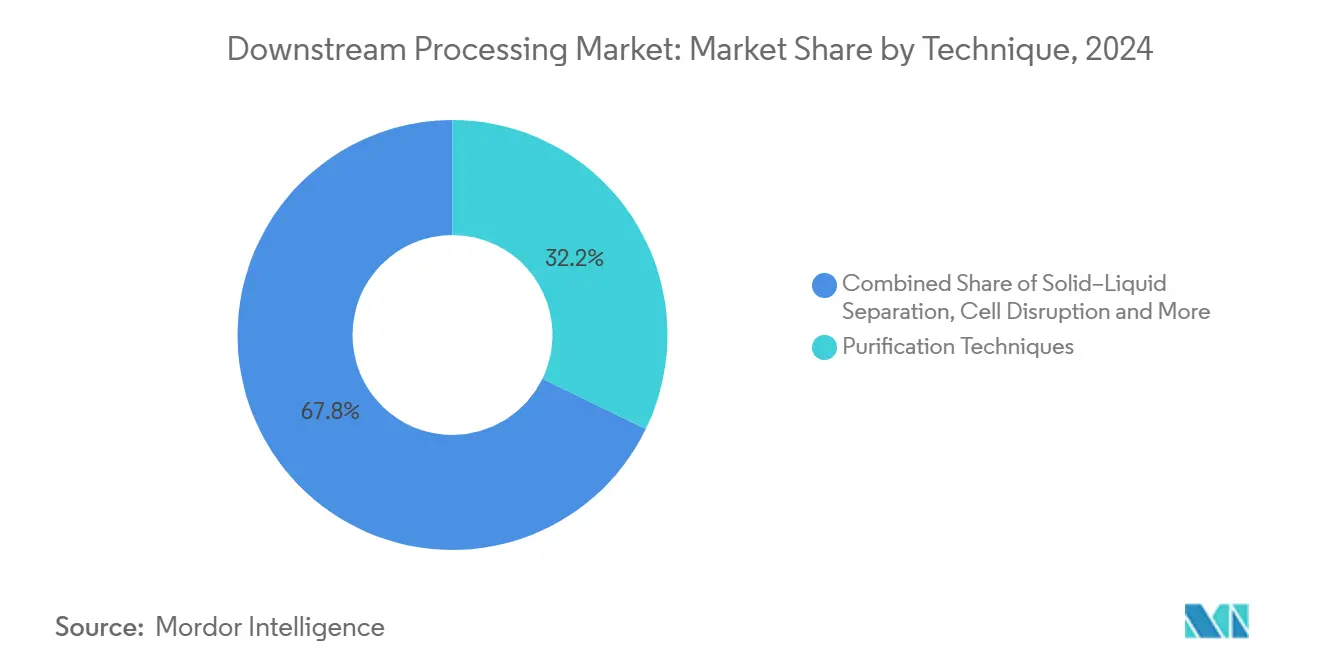
Note: Segment shares of all individual segments available upon report purchase
By Product: Chromatography Leadership Faces Filtration Innovation
Chromatography columns and resins commanded 35.53% revenue share in 2024 and continue as the reference standard for antibody capture. Yet filtration and membrane devices exhibit the highest 14.35% CAGR as PFAS-free polymer advances spur replacement cycles. The downstream processing market size for filtration products reached USD 11 billion in 2025 and is projected to hit USD 20 billion by 2030. Multi-layer depth filters reduce step count by combining clarification and fine filtration in one housing, enhancing facility productivity.
Adaptive control valves and gamma-stable flow-paths facilitate modular skid reconfiguration, appealing to CMOs juggling varied client molecules. Chromatography suppliers respond with high-throughput resin screening kits that cut process development time by 30%. Single-use hardware adoption rises despite disposal cost debates, as operators value the reduced validation burden.
By Application: Antibody Production Leads, Cell Therapy Surges
Antibody programs preserved 43.82% share of 2024 revenues, while cell and gene therapies expand at 15.26% CAGR, translating to an estimated downstream processing market size of USD 9 billion for CGT in 2025. Eight FDA approvals in 2024 validate commercial viability, powering investment in closed-system sterile filtration and viral-vector clarification technologies.
Antibody-drug conjugate pipelines introduce hydrophobic payloads that complicate purification, boosting demand for mixed-mode resins. Vaccine manufacturers leverage mRNA-specific purification resins that tolerate higher alcohol concentrations without ligand leaching. Automation prototypes for autologous cell therapy harvest are entering GMP suites, seeking to reduce manual operations that currently account for 35% of total batch labor cost.
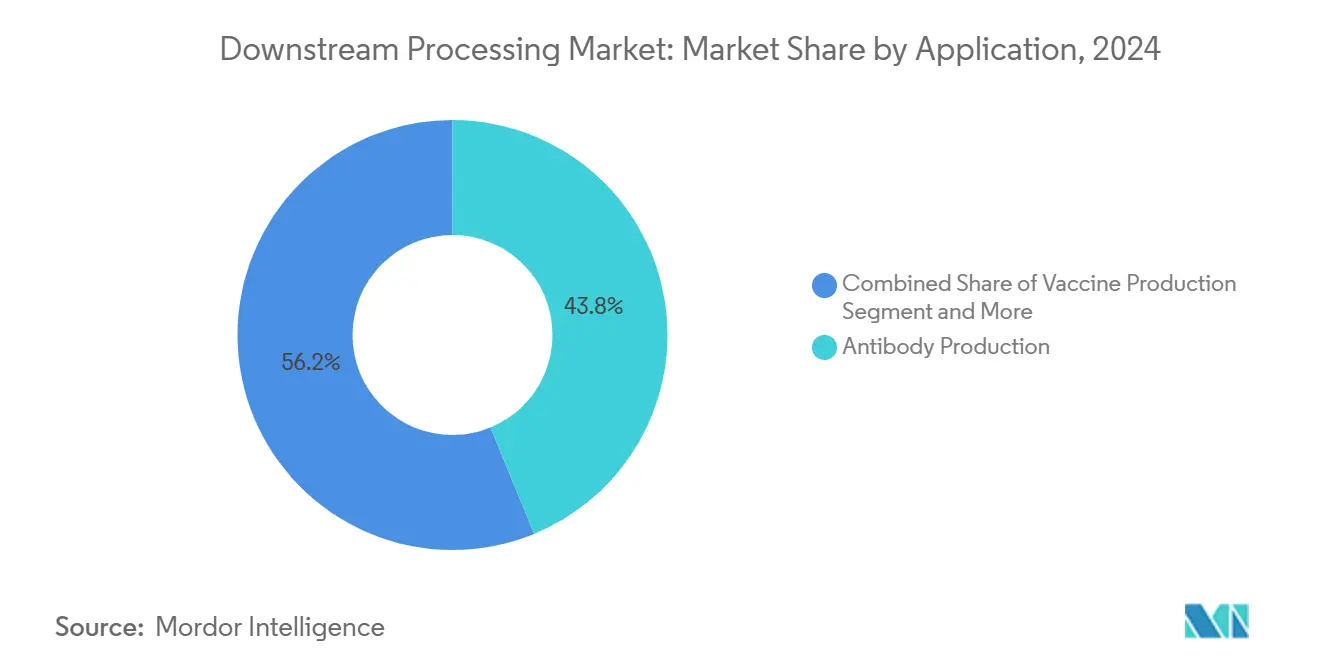
Note: Segment shares of all individual segments available upon report purchase
By End User: Biopharma Manufacturers Lead, CDMOs Accelerate
Biopharmaceutical manufacturers held 48.82% of 2024 revenue yet rely increasingly on CDMO partnerships for capacity and specialised modalities. CDMOs are projected to own the majority of downstream processing market share by 2028 as they log a 15.62% CAGR. Digital twin deployment at service providers standardises run-to-run performance, attracting small biotech clients short on in-house process development resources.
Academic institutes extend single-use adoption to shorten tech-transfer to CDMOs. Government agencies maintain niche demand for mRNA and viral-vector capacity to serve strategic stockpile goals. End-users converge on quality-by-design frameworks, pushing suppliers to embed multivariate analytics in skid controllers to smooth regulatory submissions.
Geography Analysis
North America recorded 32.82% revenue share in 2024, powered by large-scale investments such as Johnson & Johnson’s USD 2 billion project in North Carolina. Regional producers adopt continuous manufacturing in 75% of new lines and plan artificial intelligence integration within three years. The downstream processing market benefits from the FDA’s proactive stance on innovative manufacturing guidance, fostering investor confidence in novel purification platforms.
Asia-Pacific is the fastest growing region at 14.62% CAGR thanks to large-scale facilities in South Korea, China, Singapore, and India. Samsung Biologics adds 180,000 L capacity while Novartis expands its Singapore site, exemplifying a trend toward mega-facilities supporting global supply. Indian CDMOs position themselves as alternatives following the US Biosecure Act. Regional authorities subsidise workforce training to bridge process-engineering talent gaps and encourage local sourcing of filters and bags.
Europe maintains steady growth through the European Commission’s biomanufacturing strategy that supports scale-up loans and fast-track regulatory pathways[3]European Commission, “Actions to Boost Biotechnology and Biomanufacturing in EU,” ec.europa.eu. Sanofi’s EUR 1 billion multiproduct hub in France and Merck KGaA’s new German QC facility underpin resilience. Middle East initiatives such as NEOM’s precision-fermentation site broaden geographic diversification, while Brazil’s pharmaceutical sector captures new biologics investments including Novo Nordisk’s USD 1.09 billion GLP-1 expansion.
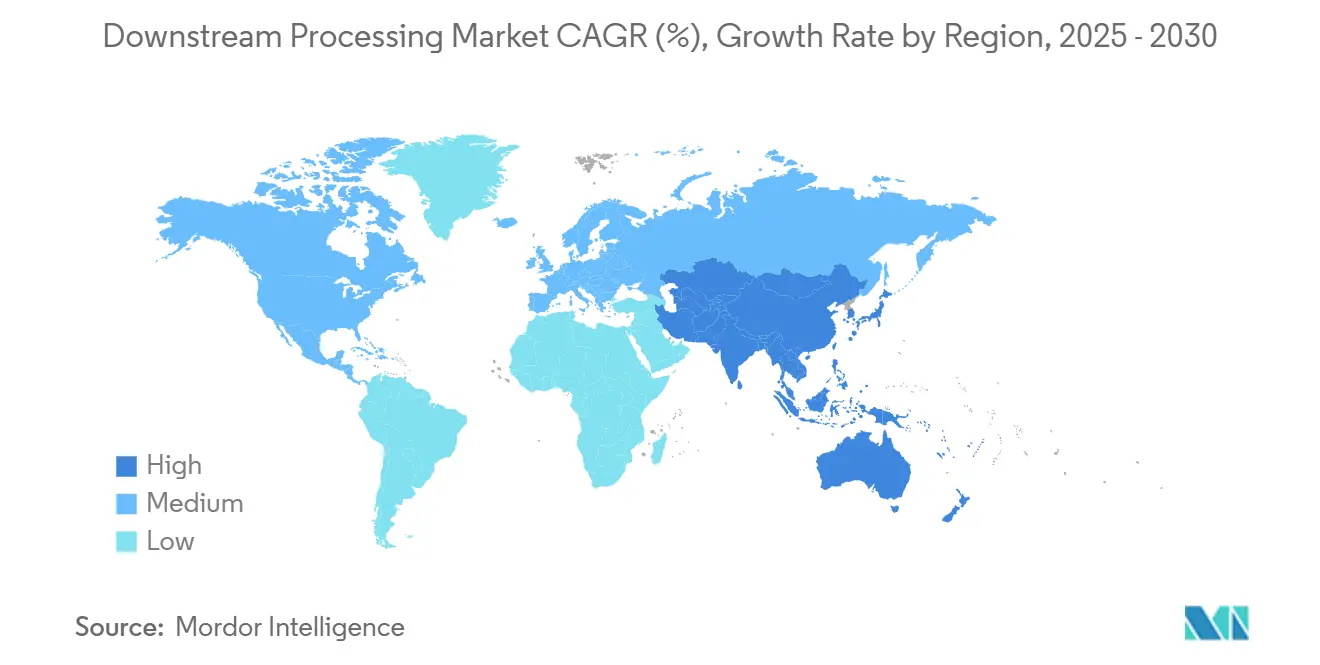
Competitive Landscape
Thermo Fisher Scientific, Danaher’s Cytiva, Sartorius, and Merck KGaA collectively account for a sizeable portion of global revenue and differentiate through platform breadth. Integrated offerings link chromatography, filtration, buffer management, and real-time analytics in one control architecture. Continuous manufacturing skids reduce operating cost by up to 42% at commercial scale, strengthening adoption among antibody producers.
Mid-tier competitors focus on niche strengths such as perfusion filters, electroporation systems, or fiber-based chromatography. Purolite’s USD 200 million resin plant in the United States targets rapid lead-time fulfillment to capture supplier switch-overs driven by cost sensitivity. Regulatory tailwinds reward firms able to certify PFAS-free consumables ahead of enforcement deadlines, giving Sartorius early-mover advantage with fluoropolymer-free membranes.
Digitalisation accelerates, with vendors embedding machine learning models to predict fouling and automate regeneration schedules. Partnerships between equipment suppliers and CDMOs shorten validation as platforms arrive pre-qualified for multiple molecule classes. Consolidation continues, but competitive intensity remains moderate because technology innovation provides several viable product-differentiation paths.
Downstream Processing Industry Leaders
-
Thermo Fisher Scientific Inc.
-
Merck KGaA (Merck Millipore)
-
Sartorius Stedim Biotech S.A.
-
Danaher Corporation
-
GE HealthCare
- *Disclaimer: Major Players sorted in no particular order
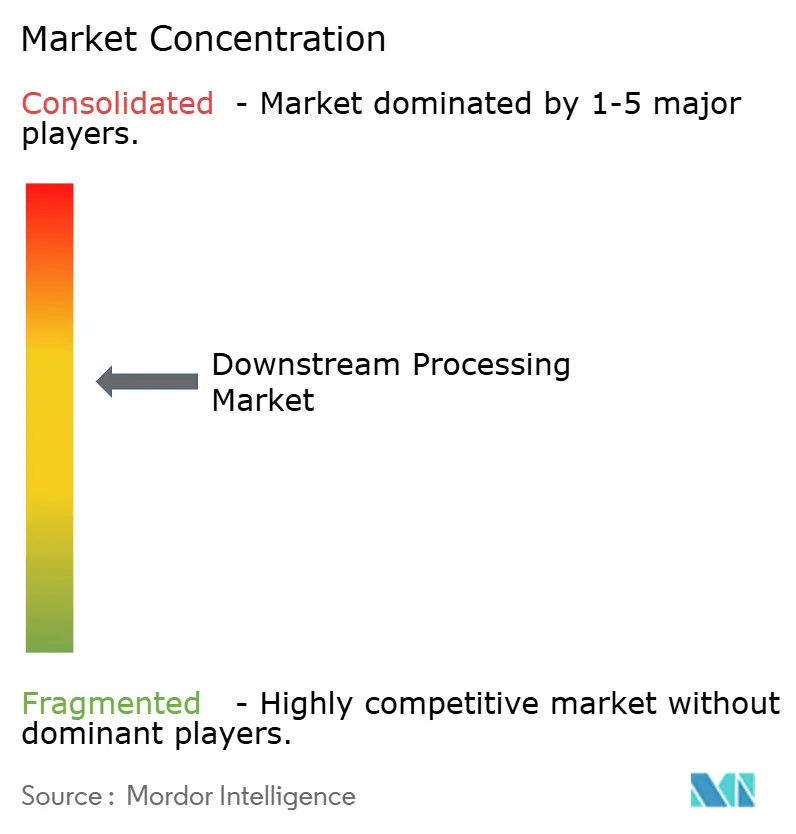
Recent Industry Developments
- May 2025: Genentech committed USD 700 million to construct a 700,000 square-foot facility in Holly Springs, North Carolina, supporting metabolic medicines and creating more than 400 manufacturing jobs.
- April 2025: NEOM Investment Fund partnered with Liberation Labs to establish a precision-fermentation biomanufacturing plant in Saudi Arabia, aiming to bolster regional food security through sustainable protein ingredients.
Research Methodology Framework and Report Scope
Market Definitions and Key Coverage
Our study defines the downstream processing market as all equipment, consumables, and related services used to recover, purify, concentrate, and formulate biologically derived products such as monoclonal antibodies, vaccines, recombinant proteins, enzymes, and hormones after upstream fermentation or cell culture. Core unit operations span solid-liquid separation, cell disruption, concentration, chromatography-based purification, and final formulation.
Scope exclusion: pilot-scale lab kits intended solely for academic teaching labs are not counted.
Segmentation Overview
- By Technique
- Purification Techniques
- Solid-Liquid Separation
- Clarification / Concentration
- Cell Disruption
- By Product
- Chromatography Columns & Resins
- Filtration & Membrane Devices
- Centrifuges
- Evaporators
- Other Products
- By Application
- Antibody Production
- Vaccine Production
- Insulin & Hormone Production
- Cell & Gene-Therapy Products
- Other Applications
- By End User
- Biopharmaceutical & Bio-similar Manufacturers
- Contract Manufacturing / Development Organizations
- Academic & Research Institutes
- Others
- Geography
- North America
- United States
- Canada
- Mexico
- Europe
- Germany
- United Kingdom
- France
- Italy
- Spain
- Rest of Europe
- Asia-Pacific
- China
- Japan
- India
- South Korea
- Australia
- Rest of Asia-Pacific
- Middle East and Africa
- GCC
- South Africa
- Rest of Middle East and Africa
- South America
- Brazil
- Argentina
- Rest of South America
- North America
Detailed Research Methodology and Data Validation
Primary Research
Mordor analysts interviewed bioprocess engineers at contract development organizations, procurement leads at top-ten vaccine makers, and regional distributors across North America, Europe, and Asia-Pacific. Expert feedback clarified average selling prices for single-use chromatography columns, utilization rates for depth filters, and the timeline for continuous downstream adoption, allowing us to realign preliminary desk figures.
Desk Research
We extracted foundational volume and value signals from public-domain sources such as the FDA's Biologics License Application database, the European Medicines Agency's EPAR files, United Nations Comtrade shipment codes for chromatography columns (HS 902780) and membrane filters (HS 842199), and industry association yearbooks from BioPlan, BPIA, and ISPE. Company 10-Ks, investor decks, and conference abstracts supplied price bands and new-capacity disclosures, which were indexed in D&B Hoovers and Dow Jones Factiva. These references illustrate our information mix; many other documents fed the analytics pipeline.
Market-Sizing & Forecasting
A top-down construct starts with global biologics production volumes (liters), multiplies them by step-wise media-to-product yields and typical consumable usage coefficients to approximate addressable demand pools, which are then priced using validated ASP corridors. Selective bottom-up roll-ups of leading supplier revenues and channel checks benchmark the totals. Key market fingerprints welded into the model include: Biologics clinical pipeline growth, new mammalian cell-culture capacity (L) commissioned per year, average chromatography column re-use cycles, adoption rate of single-use filtration assemblies, and regional vaccine dose output trends.
A multivariate regression with these drivers underpins the 2025-2030 forecast, and scenario analysis stress-tests supply bottlenecks and regulatory shifts. Gaps in bottom-up data, especially for privately held vendors, are bridged with normalized margins derived from public peers before final triangulation.
Data Validation & Update Cycle
Outputs undergo variance checks against independent shipment tallies and quarterly earnings trends. Senior reviewers sign off only after anomalies are reconciled. Reports refresh annually, and material events, such as plant closures and major capacity additions, trigger interim updates. A last-mile analyst sweep ensures clients receive the freshest view.
Why Mordor's Downstream Processing Baseline Commands Reliability
Published figures often differ because firms select distinct product baskets, pricing assumptions, and refresh cadences.
Key gap drivers in this market include whether ancillary buffers and resins are folded into totals, how aggressively single-use penetration is projected, and the currency-conversion dates embedded in each model. Mordor Intelligence reports current-year 2025 revenue at USD 40.78 billion, derived from a transparent blend of biologics output data, validated ASPs, and expert-led sanity checks, whereas other publishers either extrapolate supplier revenues without production context or lock forecasts to early 2024 exchange rates.
Benchmark comparison
| Market Size | Anonymized source | Primary gap driver |
|---|---|---|
| USD 40.78 B (2025) | Mordor Intelligence | - |
| USD 41.81 B (2024) | Global Consultancy A | Relies on unadjusted vendor revenue roll-ups; excludes filtration consumable replenishment cycles |
| USD 31.19 B (2024) | Industry Publication B | Narrows scope to durable hardware, omitting single-use columns and membranes |
| USD 39.10 B (2024) | Market Insights C | Applies static ASPs and annual refresh every second year, inflating CAGR |
In sum, while estimates vary, Mordor's disciplined scope selection, dual-path modeling, and annual refresh cadence provide a balanced, reproducible baseline that decision-makers can trust for strategic planning.
Key Questions Answered in the Report
What is the current size of the downstream processing market?
The downstream processing market is valued at USD 40.78 billion in 2025 and is forecast to reach USD 75.47 billion by 2030.
Which segment is growing the fastest in downstream processing?
Cell and gene therapy downstream workflows are expanding at 15.26% CAGR through 2030 due to rising FDA approvals and a deep pipeline of investigational therapies.
How do PFAS regulations affect downstream processing suppliers?
Pending restrictions on PVDF and related fluoropolymers are driving investment in new membrane chemistries and creating opportunities for vendors with compliant single-use products.
Which region is expected to see the highest growth rate?
Asia-Pacific is projected to register a 14.62% CAGR to 2030, driven by large plant builds in South Korea, China, Singapore, and India.
What technologies are most likely to reduce downstream processing costs?
Continuous multicolumn chromatography, intensified depth filtration, and digital twins that optimise buffer consumption can cut operating expenses by up to 42% at scale.
Page last updated on:
